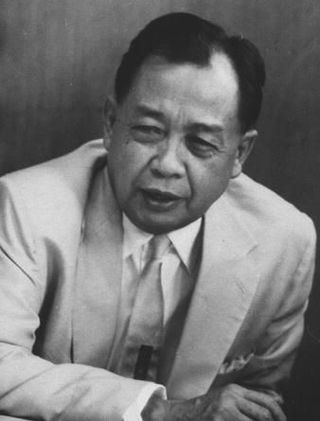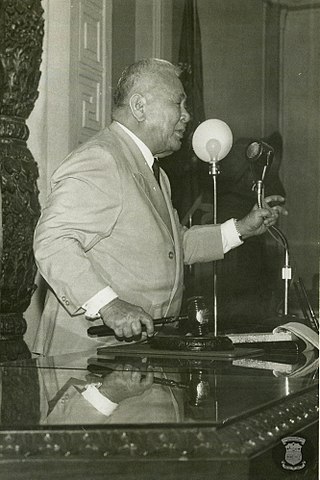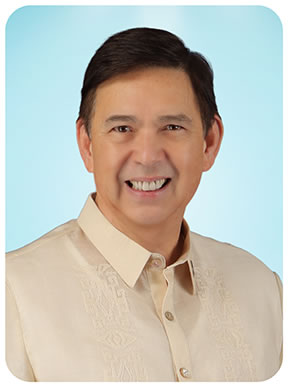
The Senate of the Philippines is the upper house of Congress of the bicameral legislature of the Philippines with the House of Representatives as the lower house. The Senate is composed of 24 senators who are elected at-large under plurality-at-large voting.

Claro Mayo Recto Jr. was a Filipino politician, jurist, and poet. He is remembered for his nationalism, for "the impact of his patriotic convictions on modern political thought", and has been seen in the same class as Dr. Jose Rizal, Sen. Jose W. Diokno, and Sen. Lorenzo Tañada.

A senatorial election was held on November 14, 1961 in the Philippines. The two candidates of the Progressive Party, guest candidates of the Liberal Party, topped the election, while the Liberals themselves won four seats cutting the Nacionalista Party's majority to 13 seats in the 24-seat Philippine Senate.

A senatorial election was held on November 12, 1957 in the Philippines. The Nacionalista Party, despite losing two seats to the Liberal Party still held the Senate with twenty seats. The Liberals who won were actor Rogelio de la Rosa and former basketball player Ambrosio Padilla.

Elections for the members of the Senate were held on November 10, 1953 in the Philippines. Incumbent President Elpidio Quirino of the Liberal Party lost his opportunity to get a second full term as President of the Philippines to former Defense Secretary Ramon Magsaysay of the Nacionalista Party. Quirino's running mate, Senator Jose Yulo lost to Senator Carlos P. Garcia. Vice President Fernando Lopez did not run for re-election and ran for the Senate instead, in which he emerged as the candidate with the most votes. This was the first time that an elected president did not come from the Senate. To further compound the Liberal Party's woes, they also failed to win any seats in the Senate in this election.
General elections were held in the Philippines on November 11, 1941. Incumbent President Manuel Luis Quezon won an unprecedented second partial term as President of the Philippines via a landslide. His running mate, Vice President Sergio Osmeña also won via landslide. The elected officials however, did not serve their terms from 1942 to 1945 due to World War II. In 1943, a Japanese-sponsored Republic was established and appointed José P. Laurel as president. From 1943 to 1945, the Philippines had two presidents. Quezon died in 1944 due to tuberculosis and was replaced by Sergio Osmeña.

Ralph Gonzalez Recto is a Filipino politician, who, since 2022, is serving as the representative for Batangas' 6th district and is one of the House Deputy Speakers. He previously served three terms in the Senate: from 2001 to 2007 and from 2010 to 2022 and had served as president pro tempore of the Senate and Senate Minority Leader. He started his political career as the representative of Batangas' 4th district from 1992 to 2001.

A senatorial election in the Philippines was held on November 8, 1955. This was a midterm election, the date when the winners took office falling halfway through President Ramon Magsaysay's four-year term.

The First Congress of the Commonwealth of the Philippines, also known as the Postwar Congress, and the Liberation Congress, refers to the meeting of the bicameral legislature composed of the Senate and House of Representatives, from 1945 to 1946. The meeting only convened after the reestablishment of the Commonwealth of the Philippines in 1945 when President Sergio Osmeña called it to hold five special sessions. Osmeña had replaced Manuel L. Quezon as president after the former died in exile in the United States in 1944.

Elections for the Senate of the Philippines were held on November 11, 1947, with eight of the 24 seats in the Senate being contested. These eight seats were elected regularly; the winners were eligible to serve six-year terms from December 30, 1947 until December 30, 1953. Gubernatorial and local elections were held on the same date.
The Preparatory Committee for Philippine Independence or the PCPI was the drafting body of the 1943 Philippine Constitution during the Japanese Occupation of the Philippines during World War II. The constitution was signed and unanimously approved on September 4, 1943, by its members and was then ratified by a popular convention of the KALIBAPI in Manila on September 7, 1943.

The Nacionalista Party is the oldest political party in both the Philippines and in Southeast Asia in general. It is responsible for leading the country throughout the majority of the 20th century since its founding in 1907; it was the ruling party from 1935 to 1946, 1953–1961 and 1965–1972.
The Nationalist Citizens' Party was a Philippine nationalist party established by Claro M. Recto and Lorenzo Tañada in 1957. Recto became its presidential candidate for the 1957 presidential election, where he was defeated, getting 9% of the vote. Tañada was eventually elected to the Senate under the party in 1959. The NCP functioned as a third party in a political climate dominated by the Nacionalista Party and the Liberal Party.

Vicente María Epifanio Madrigal y López was a Spanish Filipino businessman, industrialist and politician. Madrigal died at home in New Manila, Quezon City, under the care of his youngest daughter, Maria Luisa.

The 2016 election of members to the Senate of the Philippines was the 32nd election of members to the Senate of the Philippines. The seats of 12 senators elected in 2010 were filled during this election. The winners in this election joined the winners of the 2013 election to form the 17th Congress of the Philippines. The senators elected in 2013 served until June 30, 2019, while the senators elected in this election would serve up to June 30, 2022.
Senator Alauya Alonto was a Muslim Filipino statesman from Lanao best known for being a Delegate to the Constitutional Convention of 1934, and a two term senator of the Philippines, serving from 1942 to 1946 and 1946 to 1949.
Agustin Yreneo Artiaga Kintanar was a Filipino Visayan lawyer from Cebu, Philippines who served as Cebu's representative and assemblyman from 1925 to 1941 and from 1945 to 1949.
Esteban de la Rama was a Filipino general during the Philippine Revolution, entrepreneur and politician of the Nacionalista Party (NP), who became a member of the Philippine Senate from 1941 to 1947.
Emiliano Tria Tirona y Alegre was a Filipino politician who was a member of the House of Representatives from 1916 to 1919 and from 1931 to 1934 and was a member of the Senate from 1922 to 1928 and from 1941 to 1952. During the Japanese-sponsored Second Philippine Republic from 1943 to 1945 he was also Minister for Health, Labor and Public Education in the government of President Jose P. Laurel.












